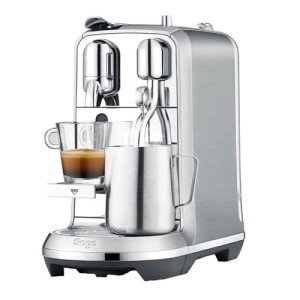A Brief History Of Retro Espresso Machines In 10 Milestones

Modern Espresso Machines: A Comprehensive Guide
Espresso has actually ended up being a foundation of coffee culture worldwide, captivating enthusiasts with its abundant taste and intense fragrance. As the need for quality espresso increases, manufacturers have actually developed a variety of modern espresso machines designed to meet diverse choices, skill levels, and budgets. This post aims to check out the technological improvements, features, and advantages of modern espresso machines, along with offer readers with practical insights into their use and upkeep.
The Evolution of Espresso Machines
To fully appreciate modern espresso machines, it is important to understand their development. The very first espresso machine, the leaver-operated machine, was introduced in the early 20th century, followed closely by pump machines in the 1960s. These developments facilitated higher pressure control, eventually resulting in a better extraction procedure.
Today, the landscape of espresso machines includes several types:
| Machine Type | Description | Target market |
|---|---|---|
| Manual | Needs ability for brewing, lever-operated to control pressure | Coffee purists, specialists |
| Semi-Automatic | Automation of water shipment; user controls grind and tamp | Home makers, baristas |
| Automatic | Immediately controls developing time; requires very little input | Casual drinkers |
| Super-Automatic | One-touch operation with integrated grinders | Convenience candidates |
| Pill | Uses coffee pods for ease of use and cleanup | Casual users |
Key Features of Modern Espresso Machines
Modern espresso machines come equipped with a series of functions that deal with various user requirements and preferences. Here's a more detailed look:
- Pressure Control: The capability to control the pressure throughout extraction is essential for achieving the ideal espresso shot. Home Page included adjustable pressure settings, allowing users to experiment.
- Temperature Stability: Consistent water temperature level is necessary for optimal extraction. Machines with dual boilers or PID controllers maintain steady brewing temperature levels.
- Integrated Grinders: Super-automatic machines typically consist of built-in mills that allow users to grind fresh coffee beans right before brewing.
- Interface: Touchscreen displays and programmable settings boost user experience by offering adjustable developing alternatives.
- Milk Frothing Systems: Integrated steam wands or automatic frothers make it easier to prepare lattes and cappuccinos.
- Self-Cleaning Functions: Many modern machines have self-cleaning options that streamline maintenance and extend the machine's lifespan.
Picking the Right Espresso Machine
When selecting a modern espresso machine, several elements need to be thought about, including budget, experience level, and wanted functionalities. Here is a list of factors to consider:
Tips for Selecting an Espresso Machine:
Determine Your Skill Level:
- Beginners may prefer super-automatic machines.
- Advanced users may enjoy manual or semi-automatic options.
Examine Your Budget:
- Espresso machines range from under ₤ 100 to a number of thousand dollars. Make sure that your choice aligns with your financial strategy.
Assess Feature Preferences:
- Decide whether you need features like an integrated grinder, advanced temperature control, or enhanced milk frothing abilities.
Think about Space:
- Measure your kitchen space, as some espresso machines can be quite big.
Read Reviews:
- User reviews can offer insight into the machine's reliability and efficiency.
Upkeep of Modern Espresso Machines
Proper upkeep is essential for making sure the longevity and ideal performance of an espresso machine. Here are some upkeep ideas:
Regular Maintenance Checklist:
Daily:
- Clean the coffee grounds from the portafilter.
- Rinse the water tank and fill it with fresh water.
- Clean the steam wand after each use.
Weekly:
- Run a tidy cycle with a descaling option.
- Clean the drip tray and any removable parts.
Regular monthly:
- Check and change water filters as needed.
- Deep clean the machine's internal elements according to the manufacturer's guidelines.
Frequently Asked Questions About Modern Espresso Machines
1. What type of espresso machine is best for newbies?
A super-automatic machine is ideal for newbies due to its simplicity. It automates the whole process, from grinding to brewing, making it simple to use.
2. How do I understand if my espresso machine requires descaling?
If you discover a reduction in pressure, sluggish developing times, or mineral buildup around the machine's elements, it might be time to descale.
3. Can I use regular coffee premises in an espresso machine?
No, espresso machines need finely ground coffee to produce the correct pressure for extraction. Routine coffee grounds are too coarsely ground and will not create the preferred outcomes.
4. Are more expensive espresso machines worth the investment?
Higher-priced models frequently use more features, better develop quality, and improved longevity. However, the very best option depends upon specific preferences and how often you plan to use it.
5. How often should I clean my espresso machine?
Daily cleansing of the portafilter and steam wand is advised. A total cleansing regimen should be carried out weekly or month-to-month, depending on usage.
The world of modern espresso machines is varied and continuously evolving, catering to a wide variety of coffee lovers-- from casual drinkers to skilled baristas. Comprehending the functions, types, and proper maintenance of these machines is vital for making an informed purchase. Whether one looks for the convenience of a super-automatic machine or the hands-on experience of a manual one, there is an espresso machine offered to please the craving for that ideal cup of espresso.

